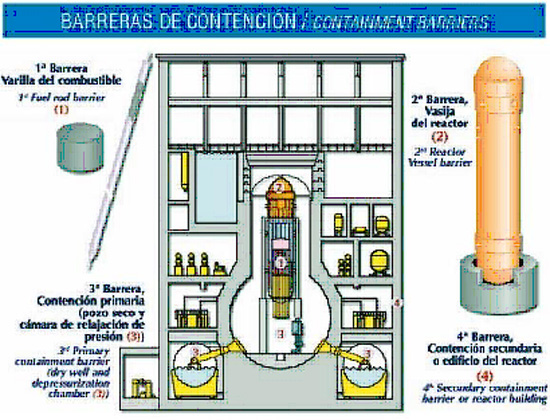2011
Fukushima-Daiichi Nuclear Power Plant, also known as Fukushima I, is one of the largest nuclear power stations in the world. It is located at the Fukushima Prefecture, on the main island of Japan, approximately 156 miles north of Tokyo, on the Pacific Ocean coast. Fukushima Daini Nuclear Power Plant is located 7 miles to the south. Both are run by the Tokyo Electric Power Company TEPCO.
Fukushima-Daiichi Nuclear Power Plant consists of six boiling water reactors (BWR, in English) which were built between 1970 and 1979:
• Fukushima-Daiichi 1: 439 MWe, built by General Electric, came into operation in 1970.
• Fukushima-Daiichi 2: 760 MWe, built by General Electric, came into operation in 1973.
• Fukushima-Daiichi 3: 760 MWe, built by Toshiba, came into operation in 1974.
• Fukushima-Daiichi 4: 760 MWe, built by Hitachi, came into operation in 1978.
• Fukushima-Daiichi 5: 760 MWe, built by Toshiba, came into operation in 1977.
• Fukushima-Daiichi 6: 1067 MWe, built by General Electric, came into operation in 1979.
Fukushima Daini consists of four boiling water reactors (BWR) with equal nominal capacitywhich were built between 1981 and 1986:
• Fukushima-Daini 1: 1067 MWe, built by Toshiba, came into operation in 1981.
• Fukushima-Daini 2: 1067 MWe, built by Hitachi, came into operation in 1983.
• Fukushima-Daini 3: 1067 MWe, built by Toshiba, came into operation in 1984.
• Fukushima-Daini 4: 1067 MWe, built by Hitachi, came into operation in 1986.
Description of Fukushima Daiichi I Nuclear Power Plant
Fukushima I-1 Nuclear Power Plant is a boiling water reactor type (BWR) that generates 460 electrical megawatts. The plant began commercial electrical production on March 26, 1971. The design corresponds to that of the first generation of this type of reactors. The designer was USA General Electric. Almost eighteen nuclear power stations were built with the same design at this stage.
The figure on the right shows a diagram of the nuclear island. In its central part, a pressure vessel contains the core of the reactor where heat is produced. Heat makes the water located in the vessel boil and turn into steam. The steam runs through turbines which in turn power the generator producing electricity. Unlike pressurized water reactors (PWR, in English), BWR do not include steam generators. Control rods operated by safety and control systems are inserted in the core, where they govern the reactions and can make them stop completely. However, ending the nuclear reaction is not enough to stop the energy production. It is also necessary to keep removing the heat produced by radioactive decay for a long time. There are several safety systems to do this.
Safety systems
The reactor has several safety systems to ensure that the heat is removed completely during any kind of potential emergency. Each system performs specific functions according to the reactor’s conditions.
• High-pressure coolant injection system
• Core spray system
• Low-pressure coolant injection system
• Automatic depressurization system
• Isolation condenser
Safety barriers
 To prevent the release of radioactive material, several barriers are introduced in nuclear power plants between it and the surrounding environment.
To prevent the release of radioactive material, several barriers are introduced in nuclear power plants between it and the surrounding environment.
• Fuel cladding: Pellets of uranium fuel are encased within sealed zirconium alloy tubes.
• Reactor pressure vessel: The reactor core is enclosed in a cylindrical vessel about 18 m high, with a diameter of about 4.7 m and a wall about 12.5 cm thick. It is designed to withstand a pressure of 88 kg/cm².
• Primary containment: It consists of a drywell and a steam suppression chamber which are interconnected. The drywell is a steel pressure vessel 16 mm thick, 32 m high and with a diameter ranging between 9 and 18 meters. It is reinforced with a concrete wall more than 1.5 m thick. The steam suppression chamber is a steel pressure vessel in the shape of a torus. Its outer diameter is 30 m and its inner diameter is 8 m. It contains about 2000 m³ of water. Both vessels are built to resist without failing even the most severe accidents foreseen during the plant design.
• Secondary containment: It is a concrete structure 1 m thick and 55 m high approximately.
Up-to-date information can be found on the following websites:
http://www.cnea.gov.ar/noticia.php?id_noticia=382
http://www.iaea.org/newscenter/news/
http://www.nisa.meti.go.jp/english/
http://www.world-nuclear-news.org/
http://www.tepco.co.jp/en/index-e.html
http://www.worldnuclear.org/
a Central Nuclear de Fukushima-Daiichi, también llamada Central Nuclear de Fukushima 1, es una de las centrales nucleares más grandes del mundo. Esta situada en la prefectura de Fukushima, la principal isla de Japón a 250km al norte de Tokyo, sobre la costa del océano Pacífico. Es gestionada por la compañía TEPCO, al igual que la Central Nuclear de Fukushima Daini situada 12km más al sur.

